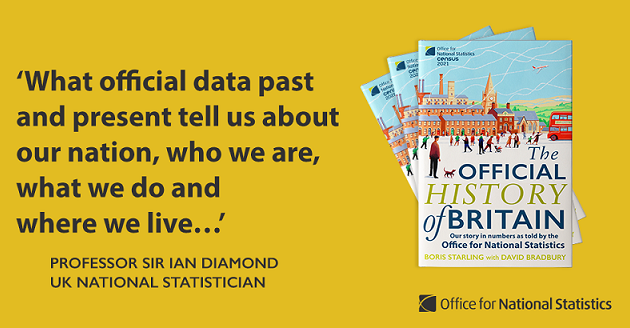The wait is over!

Today marks the publication of The Official History of Britain: our story in numbers as told by the Office for National Statistics. Described by the Sunday Times as an “early stocking-filler” and “future quizzers’ manual”, the book celebrates the richness and detail of ONS and Census statistics down the years. In this post ONS co-author David Bradbury tells readers what to expect.
As National Statistician Professor Sir Ian Diamond says in his foreword to the book, quoting the famous scientist Lord Kelvin, “if you cannot measure it, you cannot improve it.” Half of our statutory mission at the ONS is to provide reliable figures to underpin key decisions taken by government, public bodies and business. The other half is “informing the public about social and economic matters,” and that’s why we think it’s high time for an ONS book.
Next year the 2021 Census will take place against a background of events of a sort we have not seen for a century and which have thrust us and our outputs into the spotlight as never before. A timely moment, then, to step back from the headlines and look at how our statistics have told the story of the UK and its people and why the Census matters. While we’ve tried very hard to make the book approachable and above all fun, this is the very serious message that underlies it. We hope that in some small way it can help build awareness of the ONS and a wider understanding of why statistics really count.
Written by best-selling author (and former Mastermind contestant) Boris Starling, with my assistance, it covers the last couple of hundred years or so, the period from which we have official statistics from the various censuses from 1801 onwards.
There are five main parts:
Who we are: we look here not just at key population and demographic figures such as marriages, births, deaths, families, nationality and ethnicity, but also some of those ONS figures that shed more light on cultural changes, such as the names we give our babies – see pages 48-56. Well, working as I do in the ONS media relations office, I know that the annual baby names release tends to get more coverage than anything else, at least in pre-COVID-19 times, so we could hardly have left that bit out! And, as I highlighted in my previous blog, we even look at some of the most bizarre deaths that have been reported down the years – but in 2010, at least, that didn’t include anyone getting struck by lightning.
What we do: here the focus switches to the sort of jobs we used to do, as shown in old census returns, and the sorts of hours and pay that we used to, and how these have changed – new job classifications include ‘dog walker’ and ‘3-D modellers’ – “seemingly nothing to do with 1:72 scale Spitfire propellers and polystyrene cement, more’s the pity.” Homeworking probably gets more attention that it would have done if we’d written the book last year. And we also look into how things have changed in terms of industrial safety. When I dug out the old records, it tuned out that 1912 was the only year that century that more than 2,000 seafarers died in shipping accidents, perhaps not surprising when we consider that one single incident that year on its own took the lives of 685 crew members – I refer, of course, to the sinking of the Titanic (see page 173).
Where we live: this looks at where we live, not just where are the most and least densely populated parts of the country but also in terms of such things as the tenure of our new housing stock and how many young people are still living with their parents. I was surprised, when looking into it, to find that in 1941, when you might expect that lots of dwellings would have been needed to replace homes lost in blitzed cities up and down the land, the construction industry only built £22 million worth of housing, compared with £42 million spent on air raid shelters and £120 million on airfields and army depots (see page 209).
1921: a census of enlightenment: when we first began to discuss the idea of doing this book, we did not envisage that it would end up being written during a time of global pandemic, the worst since the Spanish flu of 1918-19. But it soon became clear to us that this was not a topic that we could ignore, and that the best way to tackle it was by a comparison with the situation back in 1921, the first census to be taken since the twin demographic catastrophes of the Great War and the flu pandemic. Alas, the 1921 census did not pass off without a hitch, and at that one that ended up linking the whole exercise with notorious swindler Horatio Bottomley – see page 228.
2121: back to the future: if the past is a foreign country, one where they do things differently, then the future must be a different planet altogether. We can’t really know what the 2121 census would look like (were there to be one: even beyond 2021 no decision has yet been made, though the ONS has said the census would only be replaced if we can find something better). This view of one possible future includes things like ‘transhumans’ (people artificially enhanced – the earlier term ‘cyborg’ had, it seems, failed to catch on as a result of the negative connotations from earlier science fiction) and ‘farmscrapers’ (high-rise agricultural developments). This all might sound like nothing more than a piece of fun, but it helps make a serious point: whatever the future holds for this country, we will still need to measure the key things such as how many there are of us and how much wealth we are producing.
And as the review described our book as a “future quizzers’ manual”, I can’t resist leaving you with a small sample of the sort of thing quizmasters might well be pulling out from it:
- John was the most popular name for boys in 1944, but what is the proportion of male babies who were given that name? (page 54)
- How many people claimed to be Jedi in the 2011 Census? (page 72)
- What does (or did) an ‘abcdedarian’ do to earn a living? (page 129)
- How many women were serving in the armed forces by 1944 (page 157)
- In 1844 Benjamin Disraeli described one British city as “as great a human exploit as Athens” – but which one did he mean? (page 190)
The Official History of Britain: Our Story in Numbers, by Boris Starling with David Bradbury, is published today, 15 October. To order your copy go here: https://smarturl.it/historyofbritain. You can read an exclusive first extract in the Sunday Telegraph this coming weekend, 18 October.

David Bradbury is a senior media relations officer at the ONS.